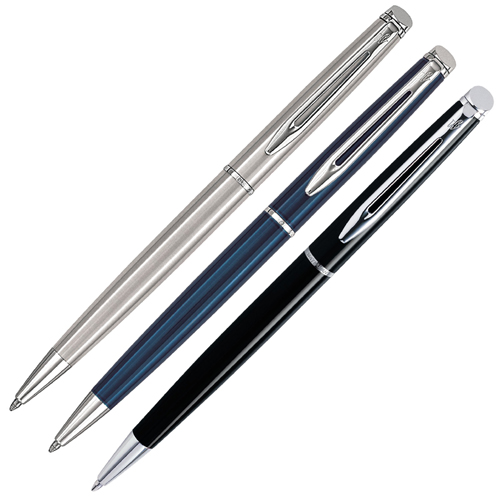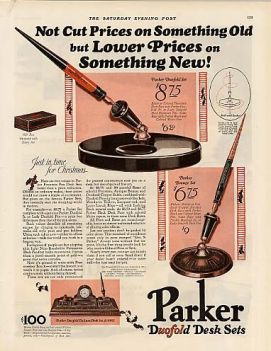 The ballpoint pen is the most common, convenient and inexpensive type of pen. Recently, it has replaced the fountain pen as the most popular tool for everyday use. Fountain pen contains a reservoir that can be refillable or disposable, this disposable type being an ink cartridge. Another popular type of pen is a marker, felt-tip pen, which has a porous tip of fibrous material. The smallest, finest-tipped markers are mainly used for writing on paper and larger ones for marking or writing on other surfaces such as whiteboards and chalkboards. Markers with wide tips and bright but transparent ink, called highlighters, are used to mark existing text. A rollerball pen is similar to ballpoint pen as it dispenses a water-based liquid or gel ink through a ball tip. Gel inks’ purpose is to combine the smooth effect of the fountain pen and convenience of the ballpoint one.
The ballpoint pen is the most common, convenient and inexpensive type of pen. Recently, it has replaced the fountain pen as the most popular tool for everyday use. Fountain pen contains a reservoir that can be refillable or disposable, this disposable type being an ink cartridge. Another popular type of pen is a marker, felt-tip pen, which has a porous tip of fibrous material. The smallest, finest-tipped markers are mainly used for writing on paper and larger ones for marking or writing on other surfaces such as whiteboards and chalkboards. Markers with wide tips and bright but transparent ink, called highlighters, are used to mark existing text. A rollerball pen is similar to ballpoint pen as it dispenses a water-based liquid or gel ink through a ball tip. Gel inks’ purpose is to combine the smooth effect of the fountain pen and convenience of the ballpoint one. The first people that we know about to use pen-like devise cut from reed or rushes were the Sumerians that inhabited Mesopotamia some 3500 years ago. This system of writing with several thousand characters was primarily used for recording commercial transactions. The Egyptians also developed their system of Hieroglyphics by initially using reeds and clay tablets but they later improved their technique by developing papyrus scrolls. Similarly, the Chinese used brushes made from animal hair dipped in inks. The Chinese also invented process of making paper but kept it secret until the 8th Century when the knowledge was acquired by the Arabs.
The first people that we know about to use pen-like devise cut from reed or rushes were the Sumerians that inhabited Mesopotamia some 3500 years ago. This system of writing with several thousand characters was primarily used for recording commercial transactions. The Egyptians also developed their system of Hieroglyphics by initially using reeds and clay tablets but they later improved their technique by developing papyrus scrolls. Similarly, the Chinese used brushes made from animal hair dipped in inks. The Chinese also invented process of making paper but kept it secret until the 8th Century when the knowledge was acquired by the Arabs.
Around the 7th century the reed pen was replaced by quills. Some of the Dead Sea Scrolls were written with the quill pens or bird feathers. Quill pens continued to be applied after the fall of the Roman Empire up until the 18th century, and were used to write and sign the Constitution of the United States in 1787.
The earliest historical record of a reservoir fountain pen dates back to the 10th century Egypt. Ma'ād al-Mu'izz, the caliph of Egypt at the time demanded a pen which would not stain his clothes and hands however it is still unclear how the pen worked. A more modern version of the reservoir pen was developed in 1636 by Daniel Schwenter. He invented a pen made from two quills: one served as a reservoir for ink inside the other. A metal pen point was patented in 1803 but it was not commercially exploited until 1822 when John Mitchell started to mass produce pens with metal nibs. Improvements in design meant that by 1831, the steel nib had become a serious competitor to the quill. There were many innovations of the classic fountain pen but it was not until the 1850s that steel pens gained widespread popularity.
 Over the years the fountain pen has continued to develop through improved filling systems, materials and nibs however it also faced competition from more recent innovations like ball-point pen which was patented in 1888 by The patent was granted to John J Loud. In 1938, a Hungarian newspaper editor, László Bíró, and his brother George began to work on designing a new type of pen with a tiny ball in its tip that could turn in a socket. As the pen moved along the paper, the ball rotated, picking up ink from the cartridge and leaving it on the paper. Bíró was issued a British patent in 1938 and later formed Bíró Pens in Argentina. By 1943 the first commercial models were available. Shortly after the invention of ballpoint pens felt tip pens and rollerballs were introduced. The first felt tip pen was invented in 1960s in Japan by Yukio Horie. Over the years marker pens and highlighters became very popular. Rollerball pens were first patented in the early 1970s and technological advances achieved during the late 1980s and early 1990s have improved the roller ball's overall performance.
Over the years the fountain pen has continued to develop through improved filling systems, materials and nibs however it also faced competition from more recent innovations like ball-point pen which was patented in 1888 by The patent was granted to John J Loud. In 1938, a Hungarian newspaper editor, László Bíró, and his brother George began to work on designing a new type of pen with a tiny ball in its tip that could turn in a socket. As the pen moved along the paper, the ball rotated, picking up ink from the cartridge and leaving it on the paper. Bíró was issued a British patent in 1938 and later formed Bíró Pens in Argentina. By 1943 the first commercial models were available. Shortly after the invention of ballpoint pens felt tip pens and rollerballs were introduced. The first felt tip pen was invented in 1960s in Japan by Yukio Horie. Over the years marker pens and highlighters became very popular. Rollerball pens were first patented in the early 1970s and technological advances achieved during the late 1980s and early 1990s have improved the roller ball's overall performance.
Although the digital world has overtaken the handwriting craft in business and general communications, writing has remained a means of expressing ones individuality. Pens still offer intellectuals an opportunity to express themselves in a more meaningful and personal way.
Did you know... ?
 A Bic Biro Chandelier was crafted by Spanish design company enPieza 'as a tribute to a classic plastic design.' This limited-edition chandelier is made from 347 polystyrene Bic Cristal pens and 347 paperclipson and is a testament to clever recycling.
A Bic Biro Chandelier was crafted by Spanish design company enPieza 'as a tribute to a classic plastic design.' This limited-edition chandelier is made from 347 polystyrene Bic Cristal pens and 347 paperclipson and is a testament to clever recycling.
More than two billion pens are manufactured in the United States annually.
The most expensive pen in the world is made from white gold, adorned with rubies, sapphires, or emeralds and accented by diamonds. It costs $ 730,000. Each pen has 840 diamonds and more than 20 carats of stones placed at the Van Cleef & Arpels patented ‘Mystery Setting’.
Most ball-point pens will draw a line 4,000 to 7,500 feet long.
The biggest collection of ball-point pens is held by Angelika Unverhau from Dinslaken. She has collected more than 220,000 pens from 146 countries. She founded a club for ball-point pen collectors who meet twice a year to trade pens.
During the heat of the space race in the 1960's, NASA decided it needed a ball point pen to write in the zero gravity confines of its space capsules. After considerable research and development, the Astronaut Pen was developed at a cost of $1 million U.S. The pen worked and also enjoyed some modest success as a novelty item back here on earth. The Soviet Union, faced with the same problem, used a pencil.

No comments:
Post a Comment